I recently became the proud owner of a bamboo shrimp, and I quickly realized that caring for these unique creatures requires some special attention. Bamboo shrimp are fascinating creatures that can be a great addition to any aquarium, but they do require specific care to thrive. In this article, I will share everything I have learned about bamboo shrimp care, so you can keep your shrimp happy and healthy.
Bamboo Shrimp require a well-filtered aquarium with neutral to slightly alkaline water. They are peaceful and should be kept in groups of at least six. They feed on algae and should be supplemented with high-quality pellets and vegetables. Regular water changes and maintenance are essential for their health.
First, it’s important to understand that bamboo shrimp are filter feeders, which means they rely on the water flow in your aquarium to bring them food. They use their fan-like appendages to filter small particles out of the water, and they can often be seen perched on rocks or plants, waving their fans in the current. To ensure your bamboo shrimp are getting enough food, it’s important to have a strong water flow in your tank, as well as a variety of small particles for them to filter.
Another important aspect of bamboo shrimp care is water quality. These shrimp are sensitive to changes in water parameters, so it’s important to keep your tank clean and well-maintained. Regular water changes and a high-quality filtration system are essential to keeping your shrimp healthy. Additionally, bamboo shrimp prefer slightly acidic water with a pH between 6.5 and 7.5, so it’s important to monitor your water parameters regularly and make adjustments as needed.
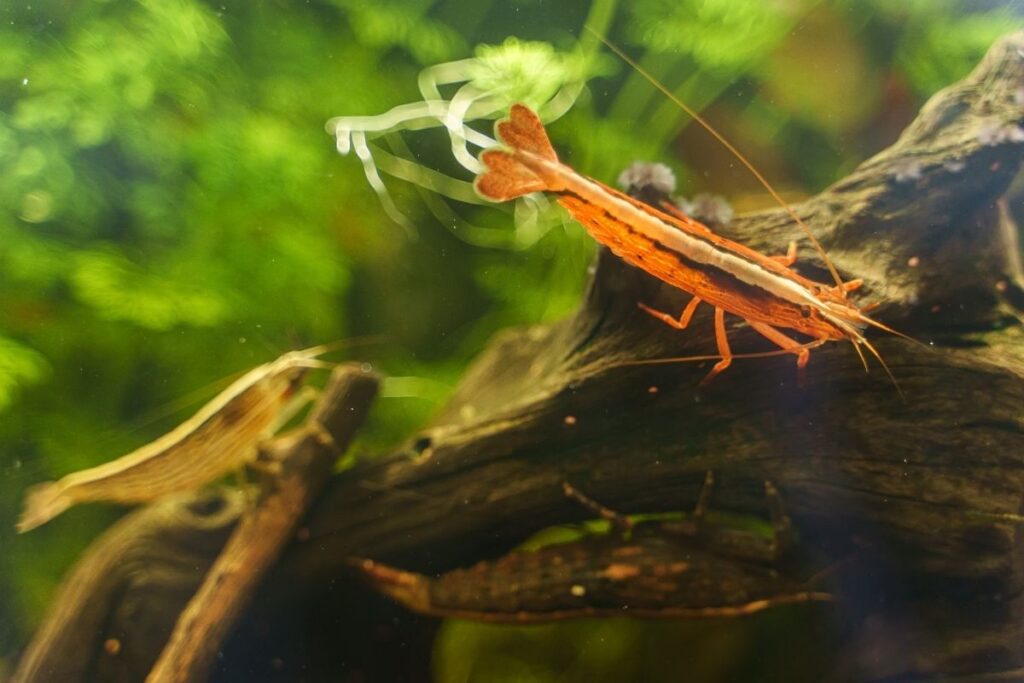
Table of Contents
Species Summary
As an aquarium enthusiast, I have found that Bamboo Shrimp are one of the most fascinating species of freshwater shrimp.
Here is what you need to know about their origin, lifespan, appearance, size, growth rate, behavior, and temperament, as well as the differences between males and females.
Origin
Bamboo Shrimp are native to Southeast Asia, specifically in the rivers and streams of Indonesia, Thailand, and Malaysia. They are commonly found in areas with moderate to fast-moving water currents and a lot of vegetation.
Lifespan
Bamboo Shrimp have an average lifespan of 2-3 years in captivity, but with proper care, they can live up to 5 years. It is important to note that their lifespan can be affected by water quality, diet, and tank conditions.
Appearance
Bamboo Shrimp have a unique appearance compared to other freshwater shrimp. They have long, slender bodies that can range from brown to grayish-blue in color.
Their most distinctive feature is their fan-like appendages that they use to filter feed.
Size
Adult Bamboo Shrimp can grow up to 3 inches in length, with males being slightly smaller than females. It is important to note that their size can be affected by their environment and diet.
Growth Rate
Bamboo Shrimp have a moderate growth rate and will molt their exoskeleton as they grow. It is important to provide them with a balanced diet and a suitable environment to promote healthy growth.
Behavior & Temperament
Bamboo Shrimp are peaceful and non-aggressive, making them a great addition to a community tank.
They are filter feeders and will spend most of their time perched on rocks or other surfaces with their fans extended, collecting food particles from the water.
Male vs Female
Male and female Bamboo Shrimp can be difficult to differentiate, but females are generally larger and have a rounder abdomen. Males also have longer antennae and a more slender body shape.
Overall, Bamboo Shrimp are a fascinating and unique species that can add a lot of interest and diversity to a freshwater aquarium. With proper care and attention, they can thrive and live a long and healthy life.
Personally, I have found that Bamboo Shrimp are a joy to watch in my aquarium. They have a calming effect as they filter feed, and their unique appearance always catches the eye of visitors.
If you’re looking for a peaceful and interesting addition to your aquarium, Bamboo Shrimp are definitely worth considering.
What do bamboo shrimp do?
As an avid aquarist, I have come to appreciate the unique qualities of bamboo shrimp.
These fascinating creatures are a joy to watch and can add a touch of elegance to any aquarium. But what exactly do bamboo shrimp do?
Well, bamboo shrimp are filter feeders, which means they spend most of their time sifting through the water for tiny particles of food.
They use their feather-like appendages to create a current that brings food particles towards their mouth.
This process not only helps keep the water clean but also provides a natural food source for the shrimp.
One interesting thing about bamboo shrimp is that they are not very active. They tend to stay in one spot and filter feed for hours on end.
This can make them appear lazy or boring to some, but I find it quite peaceful to watch them go about their business.
In addition to their filter feeding, bamboo shrimp also serve as a natural indicator of water quality. If the water becomes polluted or unclean, the shrimp will stop feeding and become less active.
This can serve as a warning sign for aquarists to take action and improve the water quality.
Overall, bamboo shrimp may not be the most exciting creatures in the aquarium, but they are essential for maintaining a healthy and clean environment.
Their unique filter feeding behavior and ability to indicate water quality make them a valuable addition to any aquarium.
Tank Setup
Setting up a tank for your bamboo shrimp is essential to ensure that they thrive in their new environment. Here are some important factors to consider when setting up your bamboo shrimp’s tank:
Tank Size
When it comes to tank size, bigger is always better. I recommend a minimum of 20 gallons for a single bamboo shrimp.
However, if you plan on keeping multiple shrimp, you’ll need a larger tank to accommodate them. A larger tank also means more space for your shrimp to move around and explore.
Lighting
Bamboo shrimp prefer low to moderate lighting. Too much light can cause stress and lead to health issues. I recommend using a low-wattage bulb or placing the tank in an area with natural, indirect light.
Filtration & Aeration
Bamboo shrimp require clean and well-oxygenated water to thrive. A good filtration system is essential to maintain water quality.
I recommend using a canister filter or a sponge filter. Aeration is also important, as it helps to increase oxygen levels in the water. You can use an air stone or a bubble wand to achieve this.
Heater
Bamboo shrimp are tropical creatures and require a consistent water temperature between 72-78°F. A heater is necessary to maintain a stable temperature in the tank.
Substrate
Bamboo shrimp prefer a soft and sandy substrate.
I recommend using a fine-grained sand or a fine gravel substrate. Avoid using sharp or rough substrate materials, as they can harm your shrimp’s delicate antennae.
Decoration
Adding decorations to your bamboo shrimp’s tank can provide them with places to hide and explore. I recommend using natural decorations such as driftwood and rocks. Avoid using decorations with sharp edges or rough surfaces.
Plants
Live plants can provide your bamboo shrimp with a natural food source and help to maintain water quality.
I recommend using plants such as java moss and hornwort. These plants are easy to care for and provide a lot of surface area for your shrimp to feed on.
By following these guidelines, you can create a comfortable and healthy environment for your bamboo shrimp to thrive in.
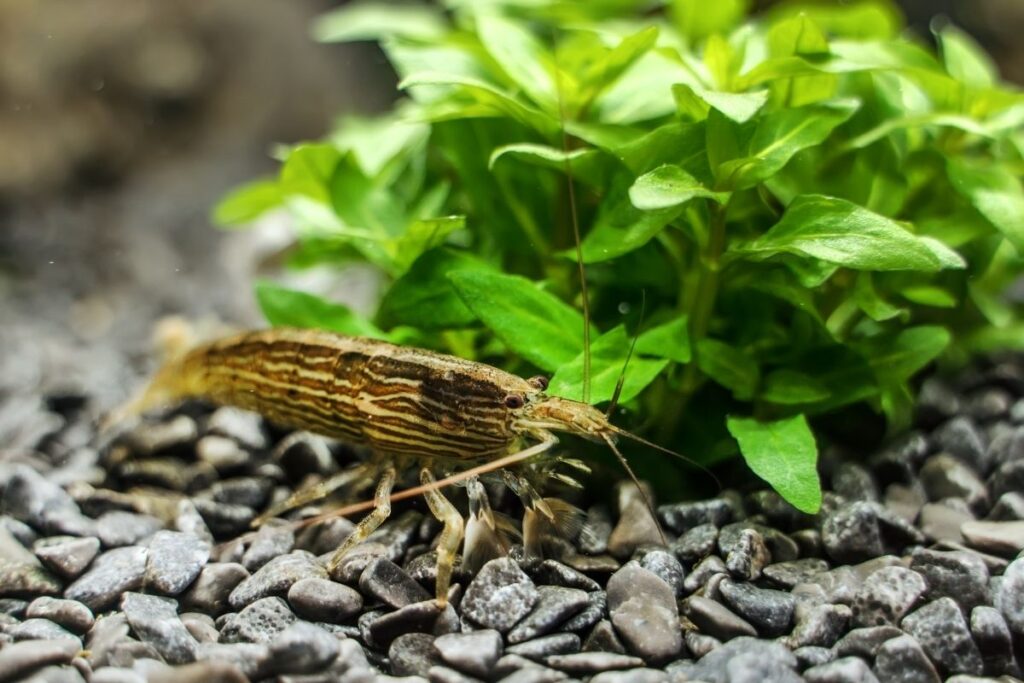
Personally, I have found that adding a few hiding places for my bamboo shrimp, such as caves or small crevices, has made them more active and playful.
It’s rewarding to see them explore their new home and find new places to hide and rest.
Water Quality
Water quality is crucial for the health and well-being of your bamboo shrimp. Maintaining the right water conditions will help your shrimp thrive and live a long life.
In this section, I will discuss the four most important factors to consider when it comes to water quality: water temperature, water pH, water hardness, and water changes.
Water Temperature
The ideal water temperature for bamboo shrimp is between 72°F and 82°F. I have found that keeping the water temperature at 78°F works best for my shrimp.
It is important to keep the temperature stable, as sudden changes can cause stress and harm to your shrimp.
Water pH
The pH level of the water should be between 6.5 and 7.5. I keep the pH level at 7.0 for my bamboo shrimp. It is important to note that sudden changes in pH levels can be harmful to your shrimp.
If you need to adjust the pH level, do so gradually over a period of several days.
Water Hardness
Bamboo shrimp prefer soft to moderately hard water, with a dGH of 4-12.
I keep my water at a dGH of 6. If the water is too hard, it can cause problems with molting and growth, so it is important to monitor the water hardness regularly.
Water Changes
Regular water changes are essential for maintaining good water quality. I recommend changing 10-20% of the water every week.
This will help remove any accumulated waste, debris, and harmful chemicals from the water.
When doing water changes, make sure to use a dechlorinator to remove any chlorine or chloramines from the tap water.
Overall, maintaining good water quality is crucial for the health and well-being of your bamboo shrimp.
By keeping the water temperature, pH level, and water hardness within the appropriate range, and performing regular water changes, you can help ensure that your shrimp live a long and healthy life.
Personal Anecdote: I once neglected to perform regular water changes and noticed that my bamboo shrimp were not as active as usual. After performing a water change, I noticed a significant improvement in their activity level and overall health. This experience taught me the importance of maintaining good water quality for my shrimp.
Tank Maintenance
Keeping a clean and healthy tank is essential to the well-being of your bamboo shrimp.
As an experienced bamboo shrimp owner, I have learned that regular maintenance is key to ensuring a thriving and happy shrimp.
One of the most important things you can do is to regularly test your water parameters. Bamboo shrimp are sensitive to changes in their environment, so it is crucial to keep the water clean and balanced.
I recommend testing your water at least once a week, and making any necessary adjustments to keep the pH, ammonia, nitrite, and nitrate levels in check.
In addition to testing the water, you should also perform regular water changes. I typically do a 25% water change once a week, but you may need to adjust this based on the size of your tank and the number of shrimp you have.
During the water change, make sure to vacuum the gravel or substrate to remove any uneaten food or waste that may have accumulated.
Another important aspect of tank maintenance is keeping the filter clean. The filter is responsible for removing impurities from the water, so it is important to clean it regularly to ensure it is functioning properly.
I typically clean my filter once a month, but you may need to do it more frequently if you have a heavily stocked tank.
Finally, make sure to keep an eye on the overall cleanliness of your tank. Remove any dead leaves or debris, and wipe down the glass regularly to prevent algae buildup. A clean and healthy tank will go a long way in ensuring the health and happiness of your bamboo shrimp.
Tank Mates
Compatible Fish Species
When it comes to choosing tank mates for your Bamboo Shrimp, it’s important to consider their peaceful nature.
I’ve found that small and non-aggressive fish species work well with Bamboo Shrimp.
Some compatible fish species include:
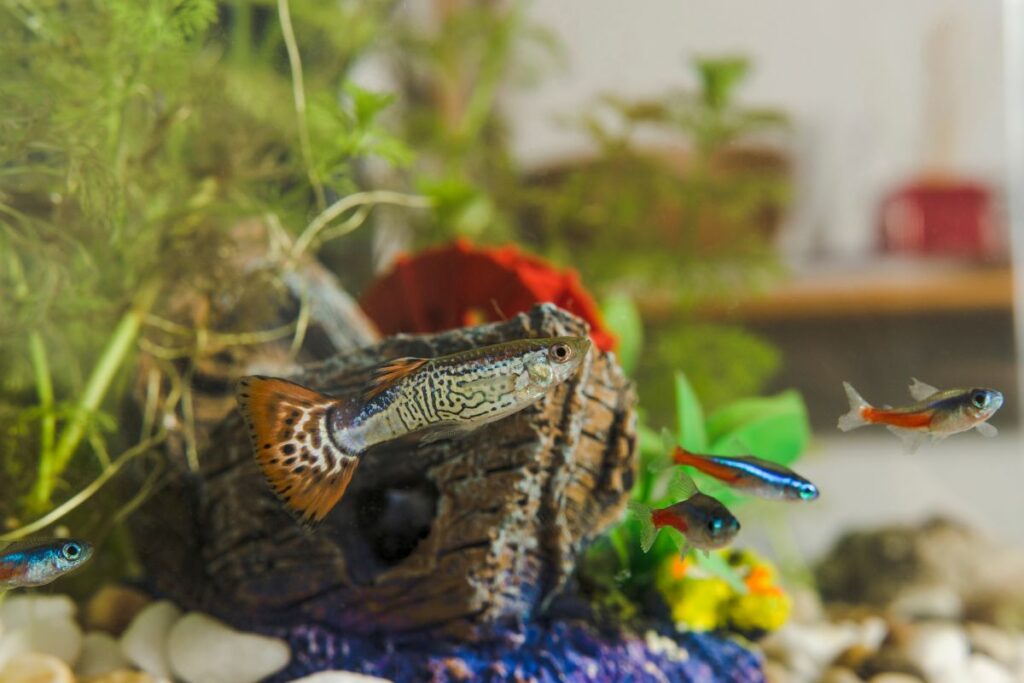
- Tetras
- Guppies
- Corydoras Catfish
- Rasboras
Incompatible Fish Species
It’s important to avoid aggressive or territorial fish species that may harm or stress out your Bamboo Shrimp.
I’ve learned the hard way that some incompatible fish species include:
- Cichlids
- Barbs
- Bettas
- Gouramis
How Many Bamboo Shrimp Should be Kept Together
While Bamboo Shrimp are peaceful creatures, it’s important to avoid overcrowding in your aquarium. I recommend keeping no more than one Bamboo Shrimp per five gallons of water.
This ensures that they have enough space and resources to thrive.
When I first started keeping Bamboo Shrimp, I made the mistake of overcrowding my tank. I noticed that they were becoming stressed and not thriving as much as they should.
After doing some research, I realized my mistake and adjusted the number of Bamboo Shrimp in my tank. Since then, they’ve been much happier and healthier.
Diet
As an experienced Bamboo Shrimp owner, I know how important it is to provide them with the right diet. Here’s what you need to know:
What To Feed
Bamboo Shrimp are filter feeders, which means they feed on small particles in the water.
They love to eat algae, detritus, and other organic matter. You can feed them a variety of foods, including:
- Algae wafers
- Shrimp pellets
- Vegetables like zucchini and spinach
- Live or frozen brine shrimp
Make sure to feed them a varied diet to ensure they get all the necessary nutrients.
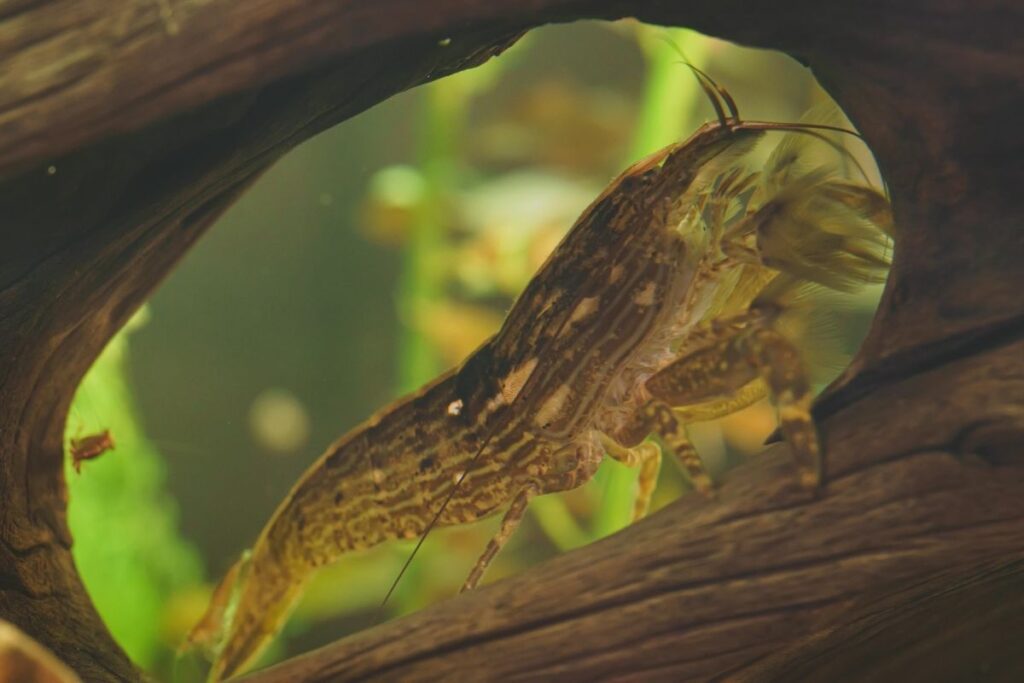
Frequency
Bamboo Shrimp should be fed once or twice a day, depending on their age and size.
Younger and smaller shrimp should be fed more frequently, while older and larger shrimp can be fed less often.
Overfeeding can lead to poor water quality and health problems, so be careful not to overdo it.
Tips
Here are some tips to keep in mind when feeding your Bamboo Shrimp:
- Feed them at night when they are most active
- Remove any uneaten food after a few hours to prevent it from decomposing and polluting the water
- Make sure the food sinks to the bottom of the tank where the shrimp can reach it
- Provide plenty of hiding places and surfaces for the shrimp to graze on
Overall, feeding your Bamboo Shrimp a healthy and varied diet is essential to their well-being.
By following these tips and guidelines, you can ensure that your shrimp are happy and healthy for years to come.
Personally, I love watching my Bamboo Shrimp eat. They are such fascinating creatures and it’s amazing to see them filter feed.
I always make sure to provide them with a variety of foods and watch them graze on the different surfaces in the tank. It’s a great way to relax and unwind after a long day!
Common Diseases
Diseases
As a bamboo shrimp owner, it is important to be aware of common diseases that can affect your shrimp.
Some of the most common diseases include bacterial infections, fungal infections, and parasitic infections. These diseases can be caused by poor water quality, stress, or poor nutrition.
Symptoms
Symptoms of these diseases can include lethargy, loss of appetite, discoloration, and abnormal behavior. If you notice any of these symptoms, it is important to take action quickly to prevent the disease from spreading.
Treatment
Treatment for these diseases typically involves improving water quality, providing proper nutrition, and administering medication.
It is important to follow the instructions on the medication carefully and to continue treatment until the disease has been completely eradicated.
Prevention
Prevention is key when it comes to avoiding common diseases in bamboo shrimp. This includes maintaining a clean and healthy aquarium environment, providing proper nutrition, and avoiding overcrowding.
Regular water changes and testing can also help prevent the spread of disease.
Personally, I have had to deal with a bacterial infection in my own bamboo shrimp. It was a stressful experience, but with proper treatment and care, my shrimp made a full recovery. Remember, prevention is key, but if your shrimp does become sick, don’t hesitate to take action.
Signs of a Healthy Bamboo Shrimp
When it comes to caring for bamboo shrimp, keeping them healthy is crucial. Here are some signs to look out for to ensure your bamboo shrimp is healthy:
- Active Movement: A healthy bamboo shrimp will be active and move around the tank. They may even climb on plants or rocks to get a better view of their surroundings.
- Feeding Habits: A healthy bamboo shrimp will have a healthy appetite and will eagerly feed on the food you provide. They will also be able to filter out particles from the water.
- Appearance: A healthy bamboo shrimp will have a bright and vibrant color. They will also have a plump and full appearance, as opposed to being thin and bony.
- Cleanliness: A healthy bamboo shrimp will keep themselves clean and groomed. They will regularly clean their antennae and legs, and will not have any visible signs of disease or infection.
Personally, I have found that observing my bamboo shrimp’s feeding habits is the best way to determine their overall health.
When I first got my bamboo shrimp, I noticed that it was not eating as much as I thought it should.
After doing some research, I realized that the water flow in my tank was not strong enough for the shrimp to filter out particles effectively.
Once I adjusted the water flow, my bamboo shrimp’s appetite increased significantly and it became much more active.
By keeping an eye out for these signs of a healthy bamboo shrimp, you can ensure that your shrimp is happy and thriving in its environment.
Signs Your Bamboo Shrimp Is Sick
As an experienced bamboo shrimp owner, I know that it’s important to keep a close eye on your shrimp’s behavior and appearance to ensure they are healthy. Here are some signs that your bamboo shrimp may be sick:
First, if you notice that your shrimp is not moving as much as usual or is not moving at all, this could be a sign that something is wrong.
Shrimp are typically very active and will move around their tank constantly, so if you notice a sudden decrease in movement, it’s time to investigate.
Another sign of illness is if your shrimp is not eating. If you notice that your shrimp is not eating, it could be due to a number of reasons, including stress, poor water quality, or illness.
Be sure to monitor your shrimp’s eating habits closely and make any necessary changes to their environment.
Changes in color can also be a sign of illness in bamboo shrimp. If you notice that your shrimp’s color has faded or changed significantly, it could be a sign that they are not feeling well.
Keep in mind that bamboo shrimp will change color slightly depending on their environment, but any sudden or dramatic changes could be a cause for concern.
Finally, if you notice that your shrimp is not using their fans to filter feed, this could be a sign of illness. Bamboo shrimp use their fans to collect food particles from the water, so if you notice that they are not doing this, it could be a sign that they are not feeling well.
Remember, it’s important to act quickly if you notice any of these signs of illness in your bamboo shrimp. By monitoring their behavior and appearance closely, you can help ensure that they stay healthy and happy in their tank.
Breeding
Breeding Setup
When it comes to breeding bamboo shrimp, it’s important to create the right environment for them to thrive. I’ve found that a tank with a minimum size of 20 gallons is ideal for breeding.
You’ll also want to make sure the water is clean and well-oxygenated, as shrimp need plenty of oxygen to survive.
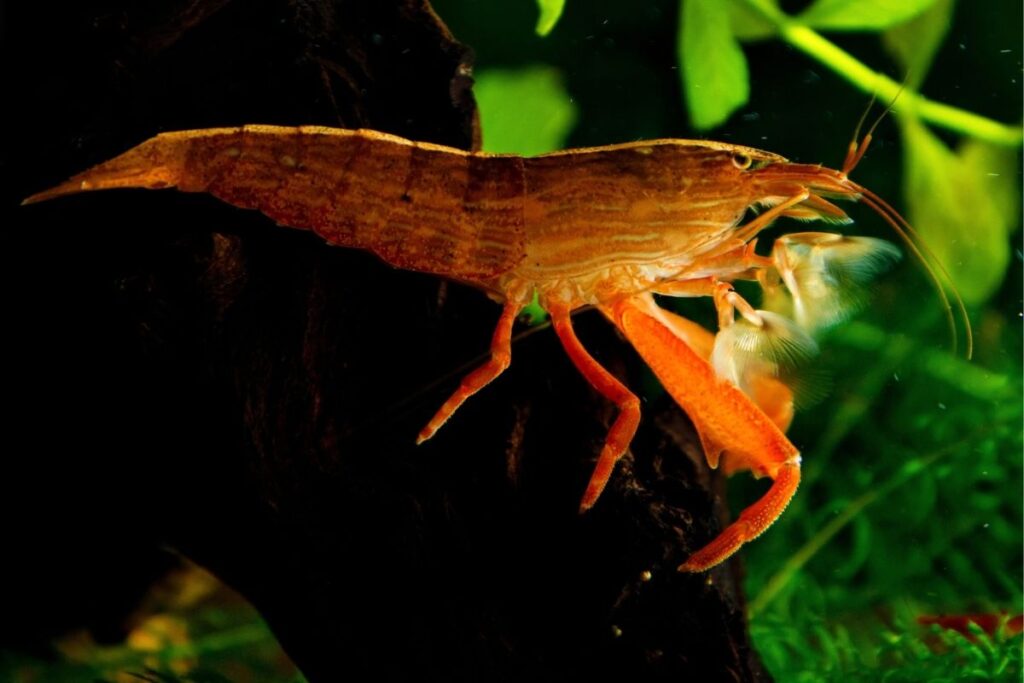
One of the most important things you can do to set up your breeding tank is to provide plenty of hiding places for the shrimp.
I like to use plants, rocks, and driftwood to create a natural-looking environment that also provides plenty of cover for the shrimp.
How To Breed
Once you’ve set up your breeding tank, it’s time to introduce your shrimp. I recommend starting with a group of 6-8 shrimp, as this will give you the best chance of success.
When it comes to breeding bamboo shrimp, the key is to provide the right conditions for them to mate.
This means keeping the water clean and well-oxygenated, and providing plenty of hiding places for the shrimp.
After a few weeks, you should start to see the female shrimp carrying eggs.
At this point, it’s important to make sure the water conditions remain stable, as any changes can stress the shrimp and cause them to abandon their eggs.
Care
Once your shrimp have successfully bred, it’s important to continue providing them with the right care to ensure their eggs hatch and their offspring survive.
This means keeping the water clean and well-oxygenated, and providing plenty of food for the shrimp and their young.
One thing to keep in mind is that bamboo shrimp are filter feeders, so they’ll need plenty of small particles in the water to feed on.
I like to use a combination of commercial shrimp food and algae wafers to provide my shrimp with the nutrients they need.
Overall, breeding bamboo shrimp can be a rewarding experience, but it does require some patience and attention to detail.
By providing the right environment and care, you can help your shrimp thrive and produce healthy offspring.
Personally, I found breeding bamboo shrimp to be a fascinating experience. Watching the female shrimp carry her eggs and seeing the tiny shrimp hatch and grow was truly amazing.
If you’re looking for a new challenge in the world of shrimp keeping, I highly recommend giving breeding bamboo shrimp a try!
Product recommendations for Bamboo Shrimp:
- Fluval Bug Bites Shrimp Formula – This is a high-quality shrimp food that is perfect for Bamboo Shrimp. It contains all the essential nutrients that your shrimp need to stay healthy and vibrant.
- API Aquarium Water Test Kit – It is important to keep an eye on the water quality in your aquarium, and this test kit makes it easy to do so. It includes tests for ammonia, nitrite, nitrate, and pH.
- Seachem Prime – This is a water conditioner that helps to detoxify ammonia, nitrite, and nitrate in your aquarium. It is safe for use with Bamboo Shrimp and other fish.
- Fluval Plant and Shrimp Stratum – If you plan on keeping live plants in your aquarium, this substrate is a great choice. It provides the nutrients that plants need to thrive, and also helps to maintain a stable pH.
- AquaClear Power Filter – This filter is highly effective at removing debris and maintaining water quality in your aquarium. It is also very quiet and easy to maintain.
- Aqueon Aquarium Water Changer – This device makes it easy to perform regular water changes in your aquarium. It is designed to be safe and easy to use, and can help to keep your Bamboo Shrimp healthy.
- Zoo Med Nano 10 External Canister Filter – This is a small and efficient filter that is perfect for smaller aquariums housing Bamboo Shrimp. It is easy to install and maintain, and will keep the water in your aquarium clean and healthy.
- NICREW ClassicLED Aquarium Light – This LED light is perfect for illuminating your aquarium and showcasing your Bamboo Shrimp. It is energy-efficient and easy to install.
- Zoo Med Aquatic Shrimp, Crab and Lobster Food – This is a high-quality food that is specifically designed for Bamboo Shrimp and other aquarium crustaceans. It contains all the essential nutrients that your Bamboo Shrimp need to stay healthy and vibrant.
Conclusion
Bamboo shrimp are fascinating creatures that require a bit of care to keep happy and healthy. While they may not be the easiest shrimp to care for, they are certainly worth the effort.
Throughout my experience with bamboo shrimp, I have learned that they thrive in a well-maintained aquarium with plenty of water flow and a varied diet. I have also found that they are sensitive to water quality, so it’s important to keep up with regular water changes and testing.
Another important aspect of bamboo shrimp care is providing them with adequate hiding spots. I found that adding a few driftwood pieces and rocks to my aquarium provided the perfect hiding spots for my bamboo shrimp.
Overall, I highly recommend bamboo shrimp to any aquarist looking for an interesting and unique addition to their tank. With proper care and attention, these shrimp can live long and healthy lives, and provide endless entertainment and enjoyment.
Personally, I have grown to love my bamboo shrimp and enjoy watching them filter feed and interact with their environment. They have become an integral part of my aquarium, and I highly recommend them to anyone looking for a unique and captivating addition to their tank.
FAQs
As I’ve mentioned earlier, Bamboo Shrimp care is not as difficult as it seems. However, there are still some questions that need to be answered. Here are some of the most frequently asked questions about Bamboo Shrimp care:
What is the ideal water temperature for Bamboo Shrimp?
The ideal water temperature for Bamboo Shrimp is between 72 and 82 degrees Fahrenheit. However, they can tolerate temperatures outside of this range as long as they’re not extreme.
How often should I feed my Bamboo Shrimp?
You should feed your Bamboo Shrimp once a day. Overfeeding can cause water quality issues and harm your shrimp’s health.
What should I feed my Bamboo Shrimp?
Bamboo Shrimp are filter feeders, which means they feed on microscopic organisms in the water. You can feed them powdered or liquid food designed for filter feeders, or you can add a small amount of spirulina powder to the water. I personally prefer using powdered food as it is easier to measure and control the amount of food I give to my shrimp.
Do Bamboo Shrimp need a special type of substrate?
Bamboo Shrimp do not require a special type of substrate. However, they prefer a substrate with a fine texture that they can easily sift through to find food particles.
Can Bamboo Shrimp live with other types of shrimp?
Yes, Bamboo Shrimp can live with other types of shrimp as long as they’re not aggressive. I have personally kept Bamboo Shrimp with Amano Shrimp, Cherry Shrimp, and Ghost Shrimp without any issues.
Do Bamboo Shrimp need a lot of space?
Bamboo Shrimp do not require a lot of space, but they do need enough room to move around and find food. A 10-gallon tank is sufficient for a small group of Bamboo Shrimp.
Can Bamboo Shrimp survive in freshwater or brackish water?
Bamboo Shrimp can survive in freshwater or brackish water, but they prefer freshwater. If you’re keeping them in brackish water, make sure the salinity level is not too high as it can harm their health.
These are just some of the most commonly asked questions about Bamboo Shrimp care. If you have any other questions, feel free to ask in the comments section below.
Reference: Wikipedia.
